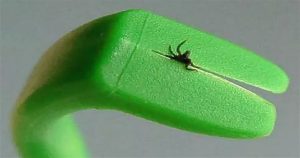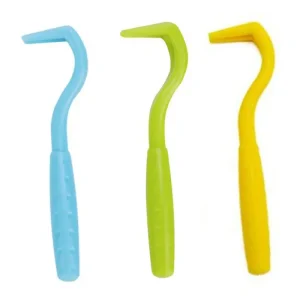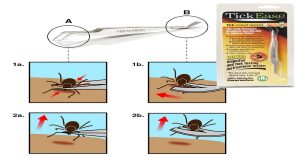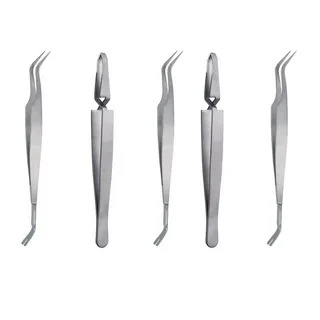Ticks are tiny but deadly insects that carry Lyme disease, Rocky Mountain spotted fever, and other tick-borne diseases. They attach themselves to the skin of humans and animals, making their removal vital for safety and health. When it comes time to remove ticks, the proper instruments can significantly affect the procedure’s security and effectiveness. This article will walk readers through desirable tools for removing ticks, offer tips on them, and guide them to pick the appropriate tool for the various situations.
Why Safe Tick Removal is Essential
Ticks attach themselves to eat blood, which is how they transmit disease. The proper removal of ticks will reduce the chance of contracting infections. However, improper techniques such as squeezing, burning, or pulling ticks away with the wrong tool can increase the likelihood of getting sick. Tools for tick removal are created to eliminate the tick in the most secure way possible, thus reducing the risk of the tick being squeezed out or leaving bits of the tick within the skin.

Key Characteristics to Look for in Tick Removal Tools
Ticks are tiny but deadly creatures that pose a health threat to animals and humans. Ticks cling to the skin to feed, transmitting dangerous diseases such as Lyme illness and Rocky Mountain spotted fever. Eliminating ticks fast and safely is vital as the right tools will make all the difference together. There are many options available. Do you know how to pick the most suitable tool for removing ticks? This article will discuss the essential qualities to look for in the tick removal tool to warrant you have a trusted tool that is easy to use and can complete the task without risk.
1. Precise Gripping Ability
The primary job is to grasp the tick securely by its mouthparts or head instead of its body. This reduces the chance of pushing the tick into the skin, which can trigger the tick to expel infectious substances in the bite. The excellent tools for removing ticks offer the finest tip that lets you be positioned close to the skin and assures you get rid of your tick without putting excessive pressure on the body.
What is it? Squeezing a tick could improve the chance of passing illnesses to the person who is. A tool with precision gripping capabilities permits you to take out the tick’s head, reducing the chance.
Tools to Think About: Fine-tipped tweezers and electronic tick removers typically give the best grip, making them perfect for tiny, deep-seated ticks.
2. Ease of Use
It is vital to remove ticks swiftly to warrant safety. Therefore, user-friendliness is an essential feature of any tool for removing ticks. When trying to get rid of ticks on your child, yourself, or a pet, require a tool that is easy to use and doesn’t need much effort or complex maneuvers. Find tools that are easy to use and ideally come with clear directions and simple steps.
What’s the significance of the use of complicated tools? It can make removing ticks more difficult, especially when dealing with more minor or challenging-to-reach ticks. An easy-to-use tool enables you to take action swiftly and efficiently, reducing stress on you and the tick’s host.
Tools to Consider: It is important to consider that the Tick Key and Tick Twister are both renowned for their easy-to-use design, making them easy to use, even for novices.
3. Versatility
Ticks can vary in size and attach to various skin types, whether on a person, pets, or in difficult-to-reach areas. An adaptable tool can remove ticks of diverse sizes and body parts without inflicting extra damage to the skin or tick. Specific tools for removing ticks have different-sized or adjustable grips that can accommodate ticks of any size, and others are explicitly designed for larger or smaller ticks.
Why it’s essential: The versatile tools for removing a tick ensure you’re ready for any circumstance, from tiny ticks on children to more giant ticks that attack pets.
Tools to Think About Tweezers and electric tick removers can be used in a variety of ways since they allow minor adjustments in grip. Twisters and Tick Twisters, as well as Tick Hooks, are available in various dimensions to fit ticks of different dimensions.
4. Reduced Risk of Squeezing
Squeezing a tick’s body could increase the risk of spreading illnesses, which is why it’s important to select a tool to prevent this. Tools that only grip the tick’s head or mouthparts will prevent the tick from squeezing, making removal more secure. To prevent this, tools for removing ticks that slide underneath the tick or feature an incline mechanism are usually chosen to reduce pressure on the tick’s body.
What is it? Preventing squeezing decreases the risk of pathogens entering the host’s bloodstream, making tick removal less risky for animals and humans.
Tools to Think About: Tick Twisters and Hooks are fantastic options for minimizing the risk of squeezing by allowing you to pull or twist the tick without putting pressure on the body.
5. Durability and Quality Materials
Quality, long-lasting materials are essential for any tick removal tool, and tick removal tools are no exception. A quality tool will not be bent or broken during use, especially when removing the tick from a challenging region. Find tick removal tools constructed from stainless steel or rigid plastic, as they are impervious to corrosion and easily sterilized.
Why it’s essential: A sturdy tool can withstand multiple uses without breaking, bending, or corroding. This ensures that you’re always ready in an emergency involving ticks.
Tools to Take into Consideration Tweezers with fine tips and Tick Keys made of stainless steel are renowned for their long-lasting properties. Top-quality polymer Tick Twisters are an excellent option.
6. Portability
Ticks are everywhere, particularly if you like to spend time outside or have pets that wander around freely. A tool for tick removal that you can carry around is small, light, and accessible. This makes it perfect for hikers, campers, or pet owners who are on the move. Many tools for removing ticks are made to be connected to keychains and easily fit into backpacks, an emergency kit, or in a pocket.
What’s the point? It lets you carry tools for removing ticks everywhere you go, so you’re ready if you encounter one.
Tools to Think About Tick Key Tick Key is an exceptionally lightweight choice because of its keychain design, and many fine-tipped tweezers are available in small travel sizes.
7. Non-Slip Design
Removing ticks requires a steady hand, specifically when dealing with small and embedded ticks. A non-slip grip or handle could help provide additional control and prevent the tool from sliding when removing the tick. This is especially helpful in removing ticks from pets that cannot remain still or are outdoors where hands could be wet or slippery.
What’s the significance? A non-slip design minimizes the danger of being dropped or tripping over this tool. This makes removing ticks easier and less likely to leave behind tick parts—the chance of leaving tick components left behind.
Tools to Think About Tweezers with fine tips and textured or rubberized grips, as well as certain types of electronic tick removers, usually come with non-slip handles that help provide additional control.
8. Safety Features for Pets and Humans
If you’re a pet owner, you’ll need an effective tool to remove ticks suitable for pets and humans. Find tools that are specifically marked as pet-safe. They typically have gentle designs and lessen stress on pets during removal. In addition, specific tools for removing ticks have features such as rounded tips or safety guards that lower the risk of injuries from accidents.
What is it? Pet-safe characteristics reduce the stress of tick removal for pets, and safety features shield and protect both tick-removing and the hosts while removing.
Tools to Consider Tick Hooks and Twisters Twisters are typically suggested for pets because they are gentle removal methods.
9. Additional Features (L.E.D. Lights, Storage Cases)
Some tick removal tool sicks have more features, such as integrated L.E.D. lights to improve visuals, magnifiers to find more minor ticks, and storage cases that keep the tool neat and ready to use. Although not lovely, these extra tools can be helpful for those who often remove ticks or work in dim conditions.
What is it? Additional features could improve the tool’s utility and help remove ticks, particularly in difficult circumstances.
Tools to Consider Electric tick removers typically have L.E.D. lights, and some tweezers with fine tips have magnifiers for greater precision.
When choosing a tick removal tool, you must look at the elements that will allow the tool to be reliable, secure, safe, and straightforward. A tool with precision gripping, durability, ease of use, and portability can provide excellent results in any situation involving ticks. If you’re trying to remove ticks from your own body or a member of your family or pet, the right tool will help make the process faster and more secure while reducing the chance of transmitting disease and discomfort.
Types of Tick Removal Tools and How They Work
There are various tools for removing ticks available, each with its own unique style and perfect applications. This article will offer a brief overview of the most popular kinds and how they function.

1. Fine-Tipped Tweezers
Description: Fine-tipped tweezers are narrow-ended or pointed tweezers that enable precise removal close to the skin.
Leading use cases: Tweezers work well for ticks of small size that are stuck deeply to skin or fur and are appropriate for humans as well as pets.

How to Use:
- Then, place the tweezers as close to your skin’s surface as possible.
- Take the tick in your body (not on the back) and pull it upwards slowly and securely.
- Do not twist or shake, which could cause the portions of your tick to split off and stay stuck to the skin.
Pros:
- Precision permits removal with precision without squeezing the body of the tick.
- It is effective on small, deeply attached ticks.
Cons:
- It requires perseverance and steady hands.
- It can be challenging to use on pets who can’t sit still.
2. Tick Key
Description: Tick Key A Tick key is a tiny metal tool shaped like an ordinary key. Its hole is designed to slip over the tick’s body, pulling it out.
Top Utilization Cases: Ideal for getting rid of more giant ticks and for use on pets or outdoor activities because of its light, portable design.

How to Use:
- Use the Tick Key over the tick with the narrow side towards the head.
- Place the tick into the slot and slowly move it through the hole that removes the tick without squeezing.
Pros:
- It is simple for those who need to become more experienced with removing ticks.
- Keychains that are easy to attach to keychains to make it easy to access your keys outdoors.
Cons:
- It’s less effective on tiny ticks.
- It can be challenging to use in areas that are difficult to reach or on wriggling pets.
3. Tick Twister
Description: The tick Twister is a plastic two-pronged tool designed to grasp the tick securely while twisting it.
Best Use Cases: The finest use cases are for larger ticks on pets and in places where you can turn without causing discomfort.

How to Use:
- Then, place the Tick Twister underneath the tick and allow it to grip tightly.
- The tool should be rotated slowly, without pulling it, until you feel the tick is free of tension.
Pros:
- Reduces the squeezing of ticks’ body, reducing disease transmission risk.
- It is easy to use and requires no knowledge.
Cons:
- It is less effective on small ticks.
- It takes some time to master the technique of twisting.
4. Tick Removal Hook
Description: Like the Tick Twister, The Tick Hook is a removal Hook with a hook device that makes it easy to remove more giant ticks.
Optimal Utilization Cases: These are useful for animals and humans, especially when ticks aren’t deep in the skin.

How to Use:
- The hook should be positioned underneath your tick to get it as close as possible.
- Lift using a steady, upward motion to get rid of the tick.
Pros:
- It is simple to use and helps reduce squeezes.
- Ideal for small and large ticks.
Cons:
- It is not recommended for small ticks or ones attached at an awkward angle.
5. Electric Tick Removal Devices
Description: The HTML0 devices are battery-operated devices that secure the tick before twisting it to release. They usually come with a light and operate with minimal manual effort.
Best Use Cases: The Top Utilization Cases are ideal for those with more giant ticks and those who prefer hands-off or require more help consistently removing the ticks.

How to Use:
- Place the device on the tick and press its gripping function.
- Twist compatible with manufacturers until the tick comes off.
Pros:
- It is simple to use and requires only a little manual effort.
- It is expected to include more features, such as L.E.D. lights, to improve visibility.
Cons:
- Typically, they are larger and cost more.
- It is not recommended for ticks with small sizes.
Tips for Safe Tick Removal
- Clean the area. Always wash the tick and skin using antiseptics before and after taking off the tick.
- Beware of squeezing the tick. Squeezing the tick’s body may cause harmful bacteria to enter the bite area, raising the risk of infection.
- Pull slowly and firmly. Quickly pulling or jerking may cause the tick’s parts to break away from the skin.
- Dispose of the Tick Properly Once the tick is removed, put it in an enclosed container or bag if it requires examination.

Conclusion: Which Tool Works Best?
When trying to get rid of ticks, the desirable tool is often based on the situation. Tweezers with fine tips are ideal for ticks with small sizes or that are deeply embedded. For pets and more extensive ticks, tools, such as the Tick Key, Tick Twister, or Tick Hook, provide reliable solutions with a lower chance of squeezing. The electric tick remover can be helpful for people who require minimal manual effort and is desirable on more giant ticks.
In any event, it is recommended that people keep at least an instrument for removing ticks on the go, particularly those who spend time in grassy or wooded areas or have pets that spend time outside. If you have the right tool and understand how to utilize it, you can assure secure, efficient tick removal, protecting you and your pets from possible health risks.
 aim specialty health Discover Expert Insights, Empower Your Wellness With Aim Specialty Health Blogs.
aim specialty health Discover Expert Insights, Empower Your Wellness With Aim Specialty Health Blogs.




